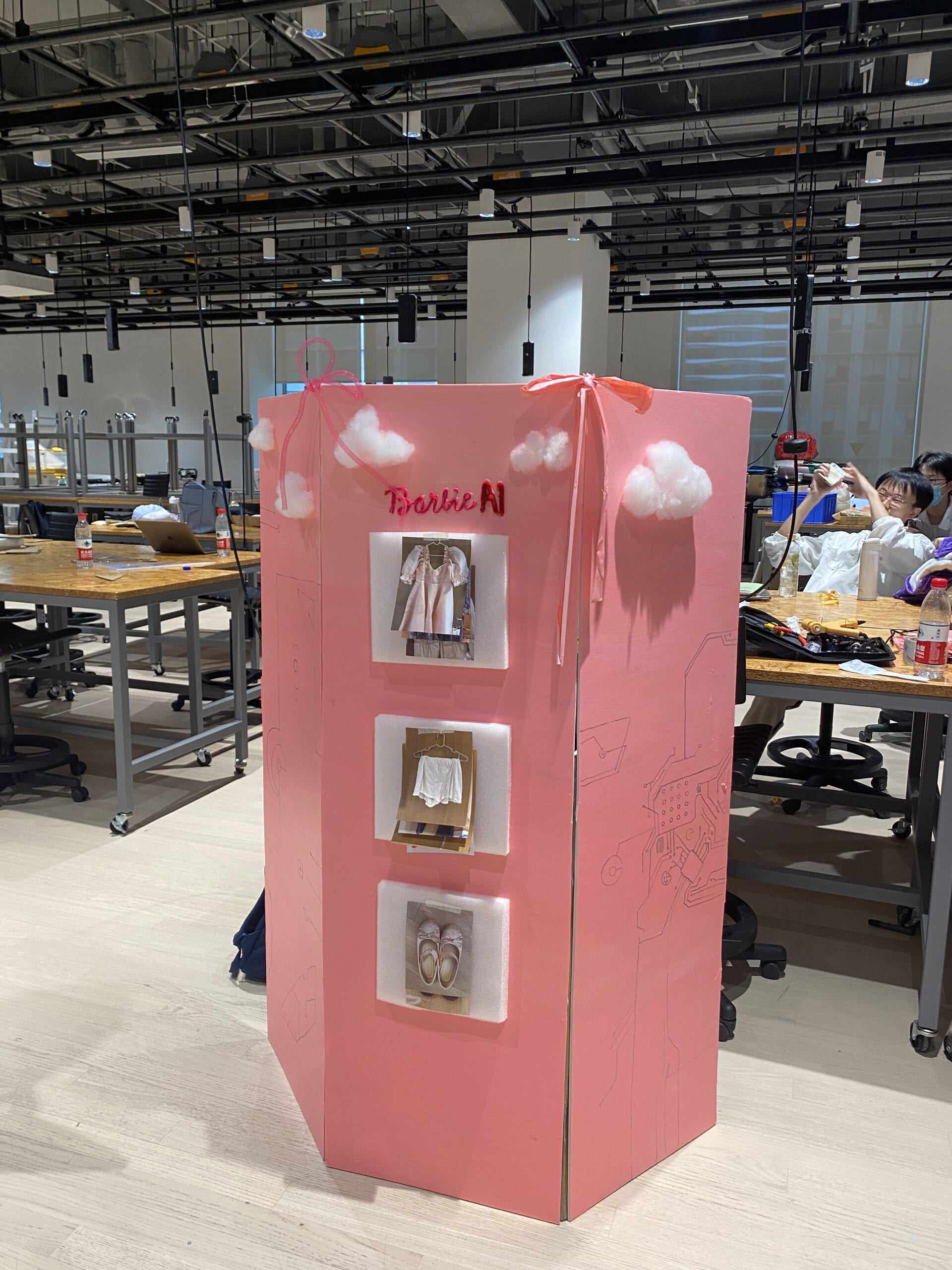BarbieAI
<iframe src=”https://drive.google.com/file/d/1CxZPJqSH9mFQ_kcUnSZ2kuVa4QBw2P7O/preview” width=”640″ height=”480″ allow=”autoplay”></iframe>
LINK: https://drive.google.com/drive/folders/1r7IMkLGfL7cV-XhwHusficOBaVEUZenP?usp=drive_link
The title of our performance is Barbie AI. I think the artifact is quite successful. The closet collects personalized biometric data by scanning your body. Then, it can surf the internet for the latest fashion trends. It will reuse fabrics already in the machine to build and tailor the next look perfect to you. It also considers your mood, environment, and weather to indicate the best outfit for the day. For all these characteristics to be in one prototype, I think it’s something a lot of people desire to have. However, there are some ethical issues to consider. Although we say the machine is able to recycle material to build new outfits, how exactly can we break down fabric and still reuse it? As well, it may kill creativity in the fashion industry when the Barbie AI can design the same things. Additionally, privacy concerns may be prevalent as the Barbie AI does share data within its machines for updates and trending clothes.
As for the design, I think it was well executed with detail since we also had an “AI voice” to replicate how the Barbie AI would function. We demonstrated how to use the machine from beginning to end through the guidance of the AI voice. The “father” also gave insights into the process which made it easier to follow for the audience. The flipping of the pictures on the foam boards showed how the machine was generating a new outfit.
BarbieAI is inspired by The Veldt because it is a component of the house that can monitor and collect personal data from people living inside the house. I believe our performance was a clear demonstration of how to use Barbie AI and the pros and cons of the artifact. We also made it clear who the target audience would be for this product which are individuals who love fashion, want to spend less time in the morning picking an outfit, and would like to stay trendy. A change that would be beneficial to this artifact is making it more inclusive such as marketing another product called Ken AI or keeping the same name BarbieAI while serving all types of fashion for the general public. Lastly, I would like to add more functionalities to the closet. Some groups were able to maneuver some of the pieces they created. I think that could have been a special touch for our project too. This could be shown by the rotations of each foam tile.
Goggles
https://drive.google.com/file/d/1oh9DhSSYkz7OjLQa20Ai_2XFzn70uXc9/view
I believe the performance Goggles was one of the clearest and most straightforward performances. They executed the product very well. It was a product derived from the Omelaas story. The audience can tell the goggles give people a new visual perception: color. The main character puts on the goggles and realizes the world is different now that he can see different emotions through color. Perhaps, he can communicate better with those around him since he made small talk with so many people with varying emotions. Something the group could have improved on was group engagement. I understood the execution of the performance, but most of the group members stood very still. I think they could have had participating roles during each segment. Because the performance was so straightforward, I think they could have been more creative as well. What happens when the machine malfunctions? In what circumstance do you have to be in for the goggles to be the most helpful? Why is this artifact beneficial to society? These are some questions that can be considered to further improve the project.
Reflection
When we were handed this assignment, I emailed the team to collect Wechats to begin brainstorming on our project. I managed the times everyone was free and had weekly meetings. Everyone was very enthusiastic about the project which made the whole experiment even more fun! Some students were busy with other things, but we definitely made it work. Everyone was supportive and engaging with each other’s ideas and suggestions. We split up our work to cut cardboard, paint, design, tape, etc. We were all active on Wechat to keep each other updated on a good idea or time to meet up. I think I had the most responsibilities in regard to planning/getting everyone together, but again, everyone had their share of work!

Who is the target audience?
- Anyone who wears clothes
- Pushing the boundaries of fashion
- Anxiety about choosing the RIGHT fit
- Wants to be stylish
What does the machine do?
- Collects biometric data (hair color, skin tone, height, body proportion, etc)
- Uses Internet access and data of other users to determine fashion trends
- Takes fabrics as an input and then personally creates and tailors clothes, reuses materials
How is it interactive?
- Monitors the body to determine the mood for the day
- Has temperature sensors for outside weather / humidity
- Favorite outfits and pieces will be pushed into prominence for other future outfits
How is it used?
- Step into box/room
- Let room scan your body and the outside environment
- Machine will determine an outfit, and the user can choose to change certain aspects.
What is the energy source?
- Solar power
What is it made of?
- Titanium
- Diamond
- Pink Plastic
- Glass
- Crystal
- Lasers
What are issues that could be caused by its existence?
- Unemployment of designers
- Effects of monopolies
- No human creativity
- Advertising in home
What are existing technologies that are similar to this concept?
- Generative algorithms
- Tiktok/insta/social media
- Cameras
- Temperature sensors
- 3d printers